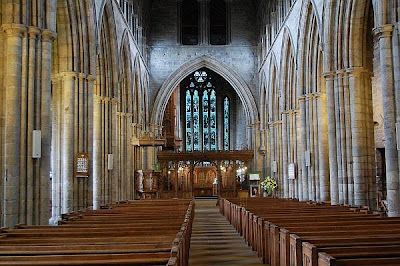The beauteous bulk of Dunblane Cathedral
 It is easy to dub Dunblane Cathedral a “no frills” kind of place. It sits like a hulk above the River Allan, its checkerboard tower denoting time, destruction, and renewal. There are no collections of detailed turrets or immaculate carvings of great men.
It is easy to dub Dunblane Cathedral a “no frills” kind of place. It sits like a hulk above the River Allan, its checkerboard tower denoting time, destruction, and renewal. There are no collections of detailed turrets or immaculate carvings of great men.
Even the headstones that surround the structure are a testament to practicality. No swooning angels or praying cherubs, just sensible rounded stones denoting sensible tales of life and death.
The doorways however, even with their sturdy bulk, are utterly gorgeous. The black iron creeps along the worn wood like scorched vines, while the deep recesses of smoothed stones cradle and unfurl, cradle and unfurl.


 Walking inside feels like stepping into a pop-up book. Suddenly you are surrounded by a huge silent space, a thousand tiny details coming into view every time you shift your gaze. I learned that the nave was without a roof for around 300 years, which is why much of the interior of the cathedral looks almost as worn as the outside.
Walking inside feels like stepping into a pop-up book. Suddenly you are surrounded by a huge silent space, a thousand tiny details coming into view every time you shift your gaze. I learned that the nave was without a roof for around 300 years, which is why much of the interior of the cathedral looks almost as worn as the outside.
At the far end of the cathedral you walk up a small spiral staircase to a gallery, where you can look straight toward the nave and down at the rows of pews, where purple hymn books are waiting to be opened. Above the large columns and arches are another row of small arched windows, through which the light emits a glow like the kind you see in documentaries about people and their experiences in the afterlife.

 There are two windows where the dominate hue is blue. To look at them, the sky is erased and the world becomes the shifting sea, all those moving tones, starting at a whitecap and sinking all the way to black.
There are two windows where the dominate hue is blue. To look at them, the sky is erased and the world becomes the shifting sea, all those moving tones, starting at a whitecap and sinking all the way to black.
If you don’t look carefully it is easy to miss the dozens of little carved wooden figures and animals that inhabit the ends of many of the pews. My favourites are a beaver frozen in mid-nibble, and a blissed-out camel.
The massive organ is also locked inside an intricate casing of wooden carvings. Try as I might I could not find the right angle to photograph it which would demonstrate just how small it made me feel to stand beneath it.



 There isn’t an old building in Scotland that does not hold on to at least one tale of human drama. Resting beneath the slabs of Dunblane Cathedral are Margaret Drummond and her two sisters, Eupheme and Sibylla. Margaret had been the mistress of King James IV. They had a daughter and it is rumoured that Margaret had even secretly married the King. In 1501 Margaret and her two sisters all died suddenly of food poisoning in Drummond Castle.
There isn’t an old building in Scotland that does not hold on to at least one tale of human drama. Resting beneath the slabs of Dunblane Cathedral are Margaret Drummond and her two sisters, Eupheme and Sibylla. Margaret had been the mistress of King James IV. They had a daughter and it is rumoured that Margaret had even secretly married the King. In 1501 Margaret and her two sisters all died suddenly of food poisoning in Drummond Castle.
Despite death by accidental food poisoning being fairly common in the 16th century, it was alleged that in a bid to clear a political path that would allow James IV to marry England’s Princess Margaret, some noblemen had deliberately poisoned the Drummond sisters. If she hadn’t died, and had the King married Miss Drummond instead of his English bride, the “union of the crowns” between Scotland and England may never have happened. For its unassuming, charming mass and hollow, quiet interior, Dunblane Cathedral is hereby one of my favourites. If you are ever in the Stirling area and have a chance to visit, be sure you do.
For its unassuming, charming mass and hollow, quiet interior, Dunblane Cathedral is hereby one of my favourites. If you are ever in the Stirling area and have a chance to visit, be sure you do.









